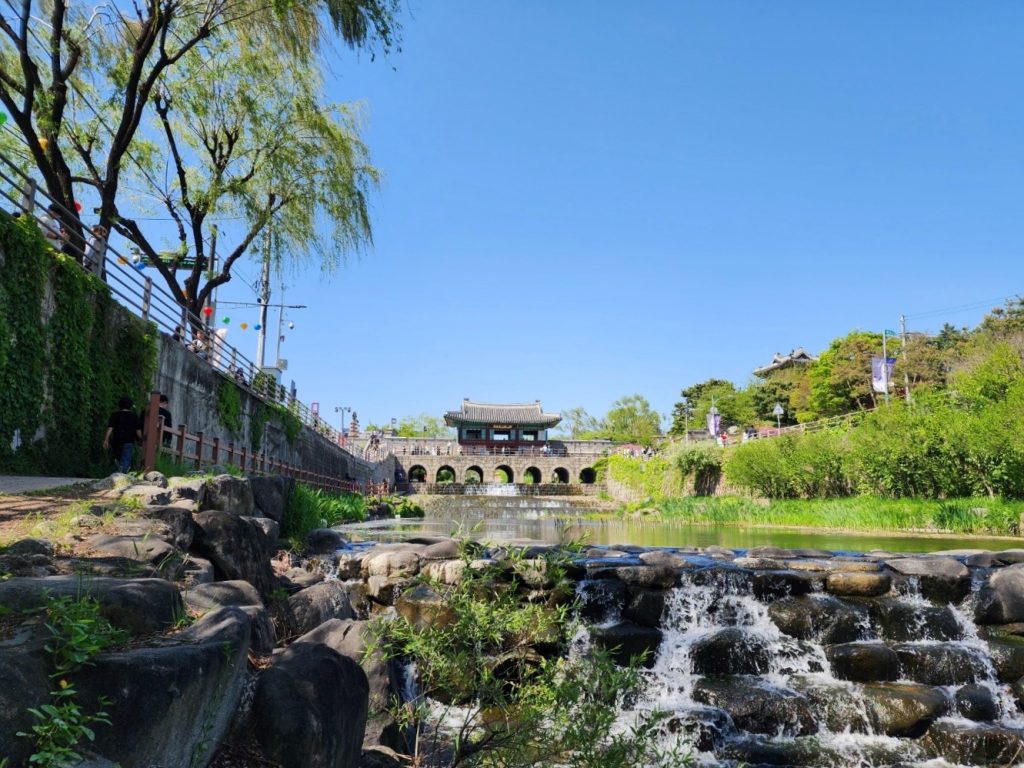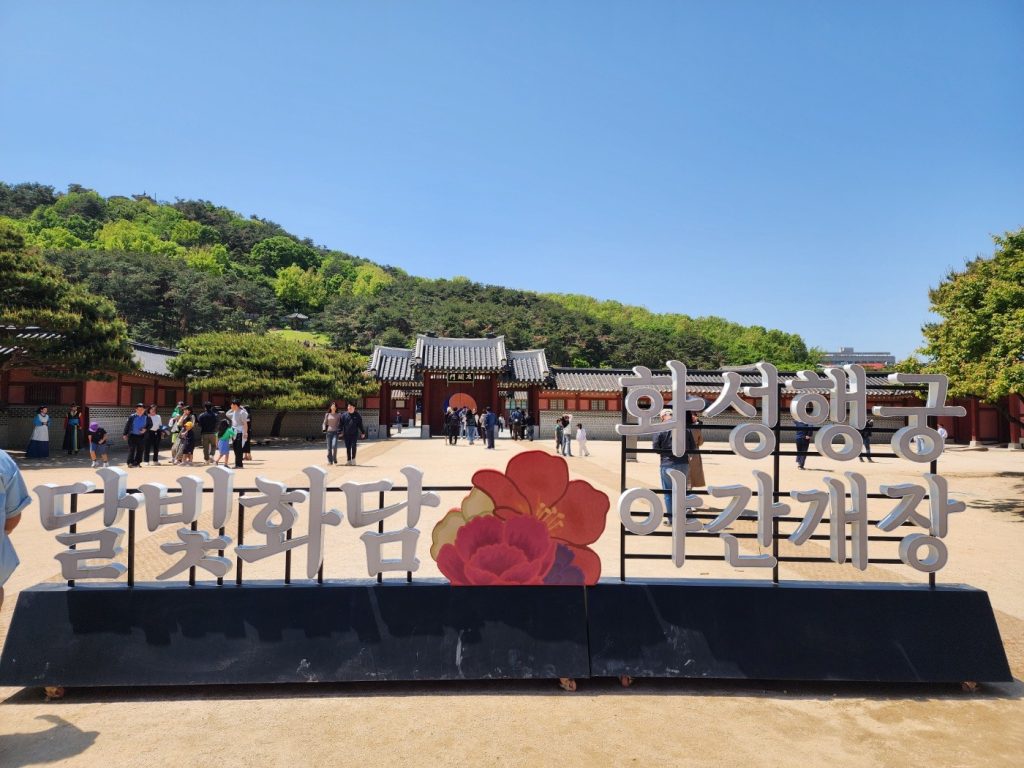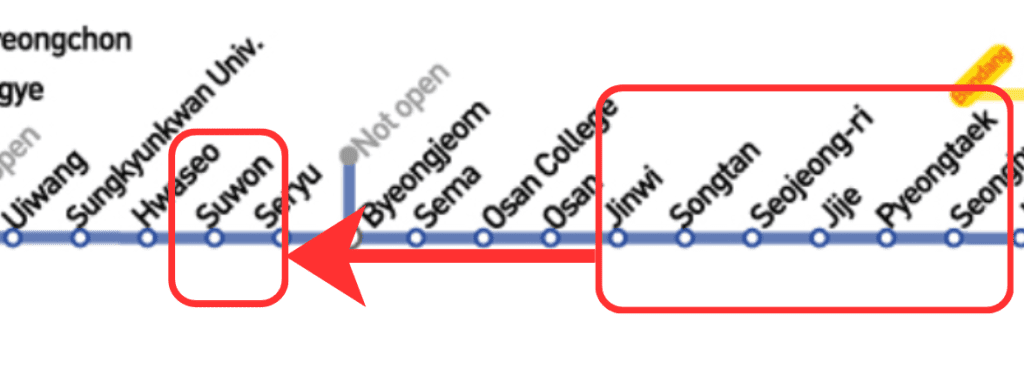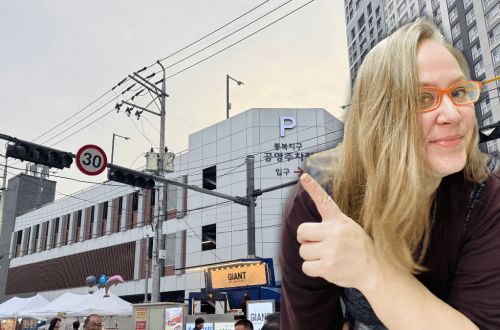
Suwon Day Trip: Fortress, Haenggung, and Fried Chicken
If you want an easy and meaningful day trip from Pyeongtaek, Suwon is one of the best choices. The moment your train rolls into Suwon Station, the giant 18th-century Hwaseong Fortress wall rises above the city, circling the heart of town. Today’s plan is simple and flexible: walk part of the fortress wall, explore Hwaseong Haenggung by day and again at night, and end with sizzling fried chicken on Suwon’s famous “Chicken Street.”
Walk the Fortress Wall (Hwaseong Fortress)
You can start your walk anywhere. Look for a nearby stairway or ramp leading up to the wall. The full loop is 5.74 km, wrapping around central Suwon with sweeping views of traditional rooftops, apartment clusters, and mountains in the distance.
- Most paths are paved
- Stairs and gentle slopes appear throughout
- Comfortable sneakers are all you need
- Walking slowly takes 2–3 hours

At the northeast corner you’ll reach Banghwasuryujeong Pavilion overlooking Yongyeon Pond. This spot is open 24/7, free, and gorgeous at sunrise, sunset, or night. Many Suwon locals call it “the best anytime photo spot.”
A Short Story While You Walk
Hwaseong Fortress was such an enormous construction project that it should have taken a decade, but instead it was finished in about 32 months (1794–1796).
Two things made this possible:
1. The Uigwe Construction Manual
The Hwaseong Seongyeok Uigwe (1801) recorded every detail of the project. They recorded the plans, tools, budgets, worker lists, and construction methods. Today, visiting Hwaseong feels like stepping inside the pages of a living engineering manual.

2. Science-Based Engineering
Practical scholar Jeong Yak-yong developed lifting devices like the geojunggi, a crane using pulleys to raise enormous stones. This is why Hwaseong is often called “the fortress built by science.”
If you pay attention to the curves of the wall and how it flows with the terrain, you’ll notice the engineering mindset that shaped every turn.
See the Geojunggi Up Close — Suwon Hwaseong Museum
After your walk, head to the Suwon Hwaseong Museum, right next to the fortress. In the outdoor yard, you’ll find full-scale reconstructions of the geojunggi, nokro (treadwheel crane), and yuhyeonggeo (siege cart). Looking at these machines in person makes the fortress suddenly feel even smarter and more human.
- Hours: 09:00–18:00 (last entry 17:00)
- Closed: Mondays
- Tickets: Included in the combo pass below
Explore Hwaseong Haenggung (Daytime)
Walk downhill from the fortress, and the wide courtyard of Hwaseong Haenggung opens in front of you. This is a palace designed horizontally rather than vertically—long wooden halls, large open yards, and peaceful lines of columns.

Bilingual signs explain each building, and you’ll find beautiful photo angles everywhere: roof curves, sunlight through eaves, and views framed by gates.
- Hours: 09:00–18:00 (17:00 in winter)
- Tickets:
- Adults ₩2,000
- Teens ₩1,500
- Children ₩1,000
- Best value: ₩4,000 combo ticket (Haenggung + Suwon Hwaseong Museum + Suwon Museum)
Night at the Haenggung (Seasonal Opening)
From May 3 – November 2, 2025, the palace opens again at night:
- Fri–Sun, 18:00–21:30
- Last entry 17:30

As the sky darkens, lanterns and soft lighting trace the wooden beams and walkways. If you visited earlier in the day, retracing the same path after dark makes Suwon feel like it has two overlapping worlds—one in sunlight and one in warm shadows.
History to Carry With You
In 1795, King Jeongjo led a famous eight-day royal procession to celebrate his mother Lady Hyegyeong’s 60th birthday and honor his father’s tomb. During this journey, he crossed the Han River on a massive pontoon bridge made by linking boats into a 20-meter-wide, 300-meter-long floating road.
That same energy, innovation mixed with ceremony, is still present in the streets and walls you’re walking today.
Optional Deep Dive — Where to See the Uigwe Later
Back in Seoul, the National Museum of Korea displays royal Uigwe materials. These illustrated manuals show procession diagrams, architectural drawings, budgets, and event planning. If Suwon sparks your curiosity, this is where you can see the original records behind the experience.
Dinner on Suwon Chicken Street
As evening settles in, walk to Suwon Fried Chicken Street, where the sound of boiling cauldrons nearly calls you inside. The signature style here is:
- A whole chicken deep-fried until the skin crackles
- Juicy meat inside
- Suwon’s local specialty: Wang Galbi Fried Chicken
The sweet-savory galbi flavor combined with crispy chicken is simple but unforgettable.
📍 Easy landmark pin (copy and paste the address below into Naver Maps):
경기도 수원시 팔달구 정조로800번길 16

A Simple, Perfect Suwon Day
Start with wind on the fortress walls, wander through the daylight lines of the Haenggung, return for its lantern-lit night scene, and finish with the warmth of fried chicken.
Suwon’s identity—a city of records, engineering, and storytelling—lives quietly in the alleys, ponds, rooftops, and museum courtyards. Next time, try doing the route in reverse, or visit at a different hour. All you need is curiosity and a camera—Suwon will meet you halfway.
Quick Transport Tip (From Pyeongtaek)
- Start at any of the subway stations in Pyeongtaek-si
- Pyeongtaek Station
- Jije Station
- Seojeongri Station
- Songtan Station
- Jinwi Station
- Get on the Northbound train headed to
- Suwon Station

About the “Shared Voices” Initiative
South of Seoul volunteers collaborate with Korean public schools to provide students meaningful opportunities to expand their English communication experience while sharing their world views with the international community in Korea.
Through guided projects, students in Korean classrooms use digital and creative tools to express themselves in English, building confidence in their communication skills. At the same time, they learn to approach writing with empathy. They participate in guided discussions that consider different perspectives, practicing cultural awareness, and developing a deeper understanding of how their words can connect communities across borders.
It’s important to know that schools in South Korea are becoming increasingly diverse, which includes the students who participate in South of Seoul programs like “Shared Voices.”

Bon Ho Gu is a junior at Jinwee High School. He loves to travel.
He also has a deep love for South Korea and looks forward to sharing his recommendations with our international community.







